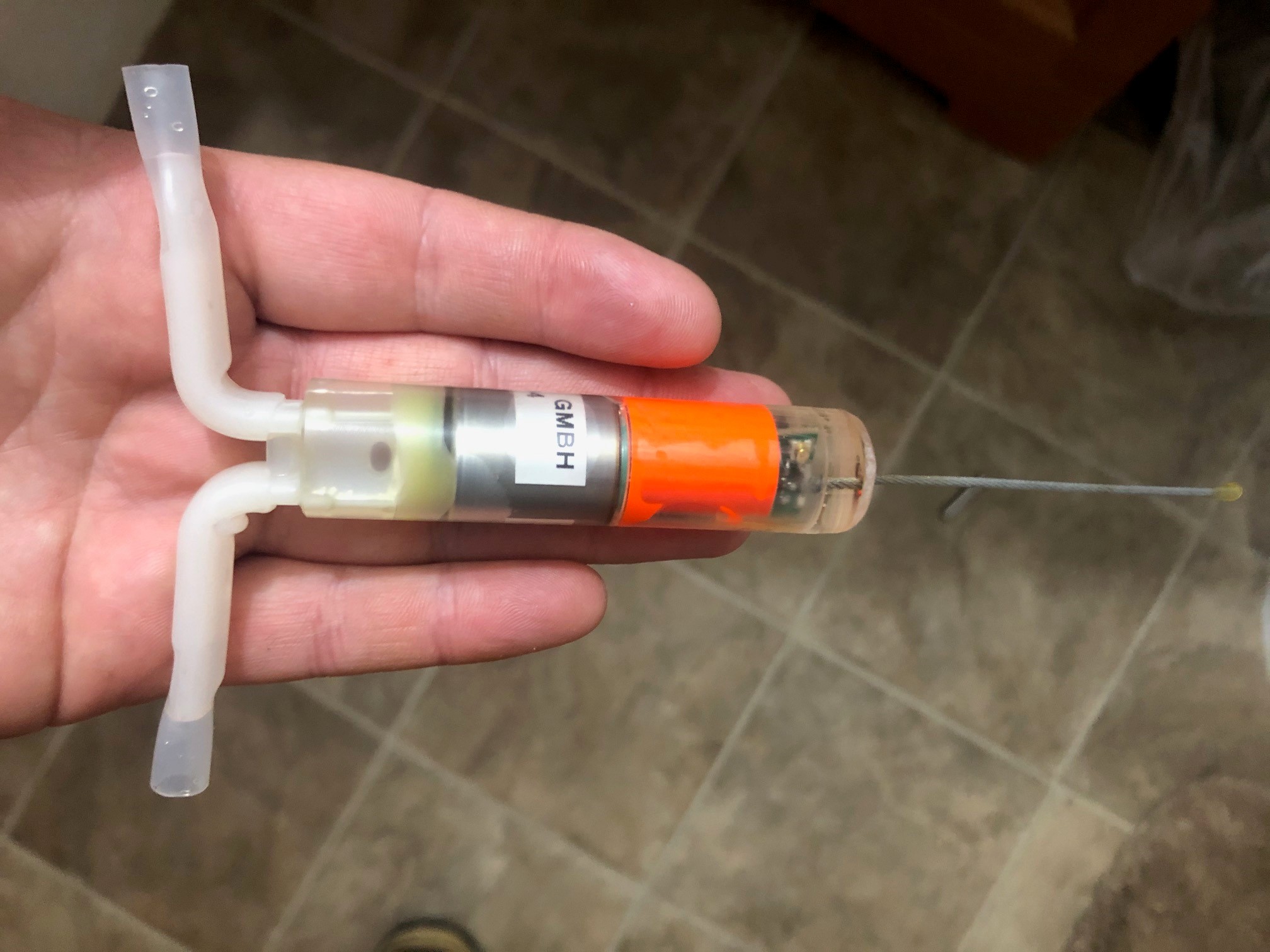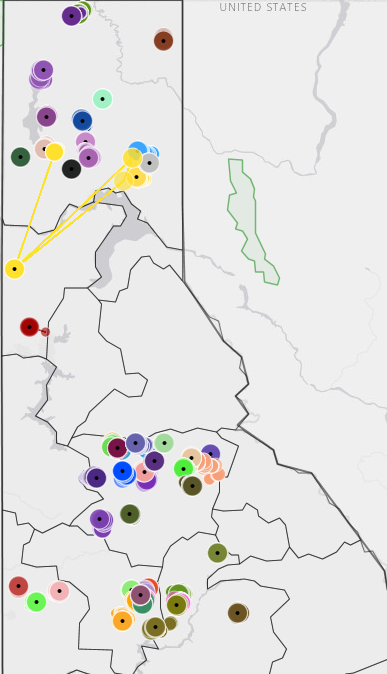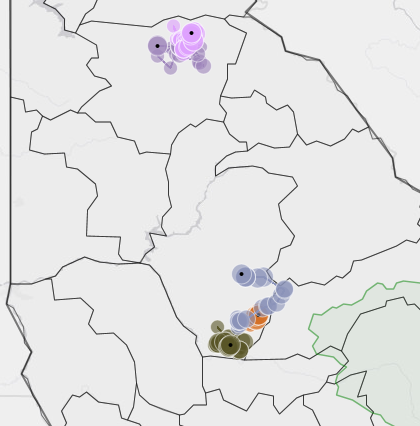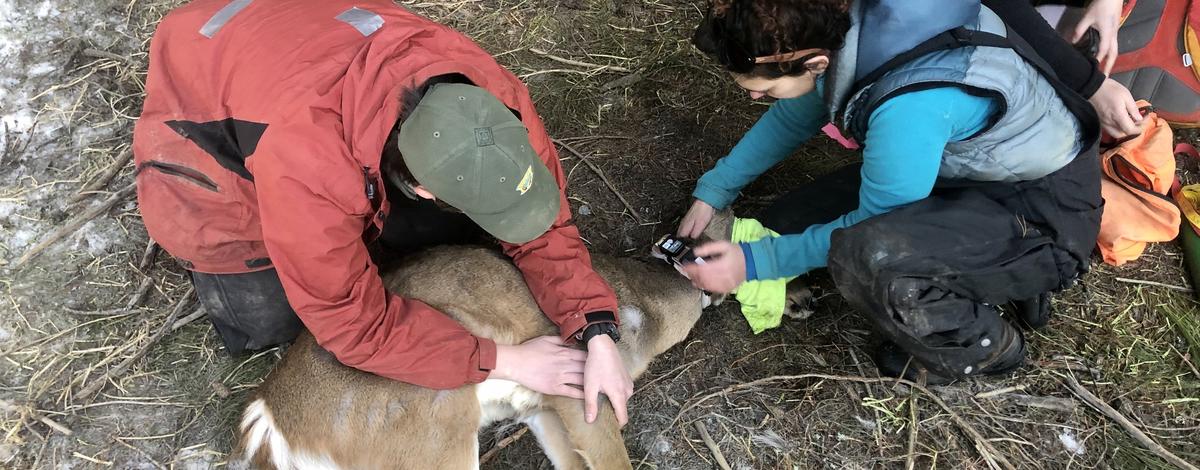Idaho research crews are busy working on several concurrent research projects to improve monitoring capabilities for big game in forested landscapes and determine how large predator and ungulate populations affect each other. Based on those interactions, managers will decide what actions would be most effective in achieving desired numbers for each population.
Overall research approach
- Continue development of new methods (mostly remote camera-based) to monitor abundance/density, vital rates, and interactions of all large mammal species in north Idaho
- Combine current ungulate survival and cause-specific mortality monitoring efforts (elk, mule deer) with new ungulate survival and cause-specific mortality monitoring efforts (adult white-tailed deer, adult moose, newborns of each species) and estimates of production (pregnancy rates) in various habitat types and predator communities throughout the state to estimate site- and species-specific ungulate population performance and primary limiting factors
- Compare and contrast ungulate population performance and nutritional condition across habitat types with varying levels of forage quality
- Simultaneously monitor major alternative prey sources for predators in an area
- Use existing predator hunting seasons and modifications to achieve a gradient of predator abundance and document the response in ungulate survival and cause-specific mortality, alternate prey abundance, and alternate predator abundance
Modeling Large Mammal Predator-Prey Dynamics to Inform Harvest Management
Timeline – 2019-2023, currently underway
Objectives
1) Use existing data and literature to model how Idaho’s predator and prey populations are altered by other competing predator or prey populations.
2) Use models to examine how harvest of one species may affect other species in the system.
Approach
Existing data is used to develop predator-prey models incorporating multiple predators (wolves, mountain lions, bears) and multiple prey species (mule deer, elk, white-tailed deer, moose). These models incorporate how the multiple predator and prey populations affect each other. Models are being formed that include species interactions and feedbacks, mainly using existing IDFG data on these populations, but also drawing from previous research in other areas. These models will allow us to explore the effects of various management strategies to optimize management across the entire predator-prey community.
Progress
The results from this project will eventually use data from all of the projects below to predict the outcomes of management actions statewide. The preliminary models have been built and are being tested in areas of southern Idaho where we have adequate data on all ungulates and predators.

May 1-9, 2020 GPS collar locations of white-tailed deer in north Idaho. Each color represents a different animal.
Influence of Habitat Quality and Weather on Ungulates in Forested Habitats
Timeline – 2019-2023, currently underway
Objectives
1) Develop techniques to estimate ungulate population density and composition in forested landscapes
2) Determine the influence of habitat quality, weather, and predation on ungulate density and productivity
3) Develop predictive models to estimate ungulate density from annual changes in habitat quality, weather, and the interactive influence of predation.
Approach
GPS collar data from white-tailed deer, mule deer, moose, and elk and remote camera surveys with newly-developed population estimation methods (Moeller et al. 2018) are used to quantify seasonal habitat selection and movements, survival, reproductive success, and the effects of severe weather and nutrition on population performance (our approach to determining influences of predation are described below, in Projects 3 & 4). Field measurements will be used and newly-produced spatial layers of vegetation composition will be used to evaluate forage quality of each habitat type and how that forage quality may change with disturbance. Landscape vegetation quality and ungulate selection to population performance will be used to develop predictive models that use habitat quality to predict population performance in various habitat types.
Progress
Currently, 211 white-tailed deer, 86 elk, 53 moose, and 4 mule deer are fitted with functioning collars in north Idaho. View the map below showing white-tailed deer locations. Interestingly, so far about half of the white-tailed deer made a migration movement to summer range, while the others are staying near the winter capture site. In summer 2020, fawns and radio-collared does will be captured to document survival and cause of death in GMUs 6 and 10A and measure moose calf mortality (see project 4).
Predator Use of Ungulates and Influence on Population Dynamics
Timeline – 2019-2023, currently underway
Objectives
1) Determine predation rates of age- and sex-specific classes of ungulates
2) Estimate biomass and proportion of diet of predator diets, including selection of different prey age classes across predator species, ages, and sexes.
3) Begin to investigate predator-predator interactions for food resources
Approach
GPS collar data is being used from white-tailed deer, mule deer, elk, and moose to estimate survival, reproduction, and cause of death for various sex- and age-classes (fawns/calves, females, males). GPS collar data will also be used from wolves, black bears, and mountain lions to determine ungulate kill rates and movement rates. Predators will be collared in the same areas to begin investigations of spatial interactions of predators. Remote cameras may also be placed at predator kill sites to examine the role of theft and scavenging between the predators and how it may influence predator-specific kill rates.
Progress
The ability to capture white-tailed deer fawns in 2019 with the capture of 36 newborn fawns in early summer was tested. Black bear predation was the primary cause of death for these fawns. In winter 2020, 60 pregnant female white-tailed deer were captured, collared and fitted them with an implant that alerts us when they give birth. Those deer will be used to capture and collar newborn fawns in the spring of 2020 in GMUs 6 and 10A. Survival and cause-specific mortality of those fawns and all the collared adults will be monitored throughout the year. Moose calf and adult survival will also be assessed (see project 4).

Vaginal Implant Transmitters (VIT's)

Moose Health and Survival
Timeline – 2020-2024, currently underway
Objectives
This project is part of a multi-state effort to understand moose declines throughout the contiguous U.S. Each state is monitoring moose vital rates in relation to habitat, disease, and predators. Prior to 2020, primary contributions to the project were an investigation of how habitat changes related to moose population performance and the development of cost effective methods to monitor moose populations. Starting in 2020, adult and calf survival, cause-specific mortality, and the effects of disease, parasites, and predators on moose across the state will be measured. Managers will use this research to inform moose season quotas and predict future moose population trends.
Approach
About 120 GPS-collared moose across Idaho that inhabit all types of moose habitat within the State will be monitored. Captured moose will have intensive health screening to document parasites and diseases prevalent in moose. Researchers will monitor survival of radio collared adult females and causes of death will be determined. A calf survival estimate will be documented through repeated observation of calves-at-heel. This will allow researchers to determine the influence of cow health on calf survival. Remote camera surveys in GMUs 1, 6, and 10A will be used to estimate numbers, assess survival, disease prevalence, and habitat use in relation to space use of predator species (i.e., wolves, bears, and mountain lions).
Progress
Researchers captured 113 moose across the State in the winter of 2019-2020. Researchers are currently monitoring 53 of these in GMUs 1, 6, 8, 8A, and 10A that will concurrently inform the other research projects listed here. Health samples have been sent to various labs for processing. Trail cameras were deployed (n = 45) in GMU 76 from early March through mid-April 2018 to test the use of trail cameras for monitoring moose abundance. The cameras took 1.2 million total photos but moose were only detected in photos from 5 cameras across 8 unique days during the study period. That investigation helped us understand that the low movement rates of moose in the winter preclude accurate camera-based estimates during that season. Photos are being processed from cameras deployed for multi-species monitoring in GMU 10A to determine moose detections. Cameras are being deployed in GMUs 6 and 10A that will be used to determine density and distribution of all large mammals, including moose, during the summer months.

May 1-9, 2020 GPS collar locations of moose currently collared in north Idaho. Each color represents a different animal.
Develop Methods for Black Bear Population Monitoring
Timeline – 2019-2022, currently underway
Objectives
1) Test if cameras can be used to estimate black bear populations in varying habitats
2) Determine if black bear recruitment can be measured based off of habitat productivity
3) Determine food habits to relate bear abundance to predation on neonate ungulates
Approach
Black bears occur in a variety of habitats throughout Idaho and are a popular game species, as well as potentially a major predator of ungulate neonates. Currently, black bear populations are monitored using harvest data, but researchers do not have a good understanding of how harvest effort affects our understanding of population status. To improve the understanding of black bear population changes, this study seeks to establish a link between black bear recruitment and habitat productivity. Radio collared bears and remote cameras will be used to estimate bear numbers and production/survival of young in each study area. Vegetation sampling transects will be designed to estimate annual mast (berry) abundance. A strong correlation between food availability and recruitment regardless of the age structure of females in the population is predicted. If true, monitoring habitat productivity can provide inference for trends in recruitment. In the future, bear camera surveys could be used to further calibrate and estimate the relationship between habitat productivity and recruitment.
Progress
During 2019, camera grids were deployed in 3 GMUs (6, 10A, 32A) to estimate bear populations and 4 black bears were GPS-collared in GMU 32A. Trapping will begin again on June 1, 2020, with the goal of 12 bears collared in each of GMUs 6, 10A, and 32A. More extensive camera grids are being deployed in all 3 study areas for summer 2020 and vegetation transects will also be completed this summer.
Influence of Predator Density on the Productivity of Other Predators and Prey
Timeline – 2020-2024, currently underway
Objectives
1) Determine the influence of predator population density on the recruitment and distribution of other predators
2) Develop noninvasive techniques to determine what prey each predator selects when competing with other predators based on varying predator densities
Approach
Movement rates of predators collared in this and other studies are used to inform a model estimating predator-specific density from remote cameras. Researchers will assess recruitment and distribution of each predator species relative to the density of other predators from remote camera images. Spring/early summer scat surveys, and genetic analysis of scats, will be used to estimate ungulate consumption by wolves, mountain lions, bears, coyotes and bobcats. Mountain lions, wolves, and bears in each of the primary study areas will be captured to understand movements and validate camera estimates.
Progress
Cameras deployed in GMUs 6 and 10A are being used by all of the studies. Within the overall camera array in a GMU, there are 2 different camera set-ups; one set-up to estimate ungulate populations (150 cameras spread randomly throughout the landscape) and one set-up to estimate predator populations (100 cameras deployed on highly-used roads/trails). Differences in abundance and behavior between ungulates and predators, result is the need for these 2 different set ups to estimate the different populations. Researchers captured and GPS-collared 7 mountain lions in GMUs 6 and 10A this winter. Department trappers will be working throughout the summer to capture and collar wolves in GMUs 6 and 10A.

May 1-9, 2020 locations of GPS-collared mountain lions in north Idaho. Each color represents a different animal.
Camera estimation of deer and elk abundance and productivity
Timeline – 2019-2023, currently underway
Objectives
Due to increasing flight costs, decreasing availability of helicopters, and safety concerns associated with traditional aerial surveys methods for mule deer and elk abundance estimation, in addition to the fact the aerial surveys aren’t feasible in north Idaho landscapes with dense conifer cover, the Department set out to examine alternative methods for estimating elk and deer abundance and vital rates using remote cameras. In prior collaborative projects with the University of Montana, methods are developed that utilize remote cameras to produce abundance and density estimates for elk, mule deer, mountain lions, wolves, and mountain goats. The objectives of this ongoing project are to continue to refine the camera-based abundance estimation methods for all species of interest, to develop specific methods to estimate age-class specific survival from cameras, and to develop methods and protocols to conduct multi-species monitoring with one camera deployment.
Approach
Cameras are deployed on grids within elk winter range in GMUs 6 and 15 and mule deer winter range in GMUs 66, 69, 72, and 76 during the winter of 2018-19 to produce the state’s first camera-based abundance estimates of elk and mule deer. The estimates from those deployments were reasonable and the mule deer estimate compared closely with a concurrent aerial survey. Camera-based estimates will be produced in other areas across the state and in other seasons to evaluate the best methods for monitoring moving forward. Researchers will examine the use of one camera deployment strategy to produce estimates for all species (i.e., multi-species monitoring).
Progress
Multi-species camera arrays are deployed in GMUs 6 and 10A (250 cameras per GMU) that will produce an estimate of all ungulate and large mammal species, including deer and elk. Cameras will be deployed from spring-fall 2020, when SD cards will be retrieved. Cameras will remain out with new batteries and SD cards to evaluate differences in estimates across seasons for each species. These camera arrays, combined with species-specific pregnancy rate data, will also be used to produce the first camera-based estimates of elk and deer calf/fawn survival. For white-tailed deer, data comparisons will be conducted of camera-based fawn survival estimate to the estimate of fawn survival from collared fawns.
Camera estimation of buck antler quality/age structure
Timeline – 2019-2021, currently underway
Objectives
Traditionally, managers used proportion of harvested bucks with 4 or 5 points on the right antler as a measure of buck age structure. However, factors other than age affect antler development and number of points (e.g., genetics, nutrition, injuries, etc.), making that metric alone an unreliable indicator of male age structure or antler conformation. Flinn et al. (2015) developed a method for estimating size and conformation of white-tailed deer antlers from photographs. We will explore use of a similar, though likely simplified, method of quantifying antler size from remote camera photographs collected during the concurrent projects. Our goal will be to develop a method managers can use to efficiently categorize male white-tailed deer by antler size, allowing them to monitor effects of management actions designed to change antler size and male age structure.
Approach
The authors of the above mentioned publication produced a commercially available computer program and phone app to produce Boone & Crockett antler scores from pictures of male white-tailed deer by using reference measurements (e.g., width of eye) relative to antler measurements. Researchers will determine how this app, which was developed on white-tailed deer in the eastern U.S., works for scoring white-tailed deer from Idaho. Researchers will also investigate if the app works for scoring mule deer in Idaho, and if not, how we might develop a similar system for mule deer. Researchers also hope to develop a system for biologists and managers to utilize remote camera images to qualitatively categorize bucks into age classes (based on body formation) and relate that to antler scores to examine correlations between antler quality and age class.
Progress
The accuracy has been tested of the commercial app for scoring Idaho white-tailed and mule deer. It proved to be very accurate (+/- 1” B & C score) for white-tailed deer but didn’t produce accurate measurements for mule deer. Researchers will examine the development of a similar tool for mule deer and begin to examine picture-based relationships between antler quality and age class for both species.
Buck survival and habitat use during hunting season
Timeline – 2018-2023, currently underway
Objectives
Managers must understand relationships between natural and anthropogenic features of a landscape and buck vulnerability to harvest to adequately manage buck age structure or antler size. Across Idaho, an evaluation of the influence of harvest seasons on survival of all age classes of male white-tailed deer and mule deer. This project will predict the effects of season structure and habitat security on the survival of adult male deer. Because one season type or structure will not produce the same mortality results in GMUs of different hunter access and security cover, researchers will alternate through tests of season type and habitat security while maintaining adequate control GMUs. This project will capitalize on current monitoring efforts for some capture costs, and supplement captures where needed, and the statewide vegetation map to provide vegetation security cover estimates. The research will provide managers with objective estimates of the effects of changing hunting season structure or habitat security, with the goal of maintaining hunter opportunity.
Approach
All male deer age classes (fawn, yearling, and mature) with GPS transmitters to identify survival, movement, and habitat use in up to 16 GMUs across the State (not all GMUs monitored concurrently). North Idaho GMUs will include at least 1, 6, 10A, and 15. Simultaneously, hunter activity will be monitored through roving census, GPS units carried by hunters, or mandatory harvest reporting. Survival of bucks will be determined dependent on the above GMU treatments. A predictive mortality model can then be developed to estimate the effects of changing season structure or vulnerability. Six month old males will receive a GPS collar or GPS eartag that will remain on the animal 1 year to evaluate yearling buck survival. Yearling and adult bucks will receive an expandable GPS collar that will accommodate neck expansion during the rut. GPS transmitters will be used to evaluate individual behavior and use of security cover related to hunting pressure, rut activities, and mortality cause.
Progress
To date, movements and survival of male white-tailed deer in GMUs 1 (5 bucks), 6 (19 bucks), 10A (15 bucks), and 15 (11 bucks) are being monitored . Researchers will continue to collar and monitor male deer for the remainder of these concurrent projects, and will hopefully add a sample of collared mule deer in north Idaho in the coming years.


